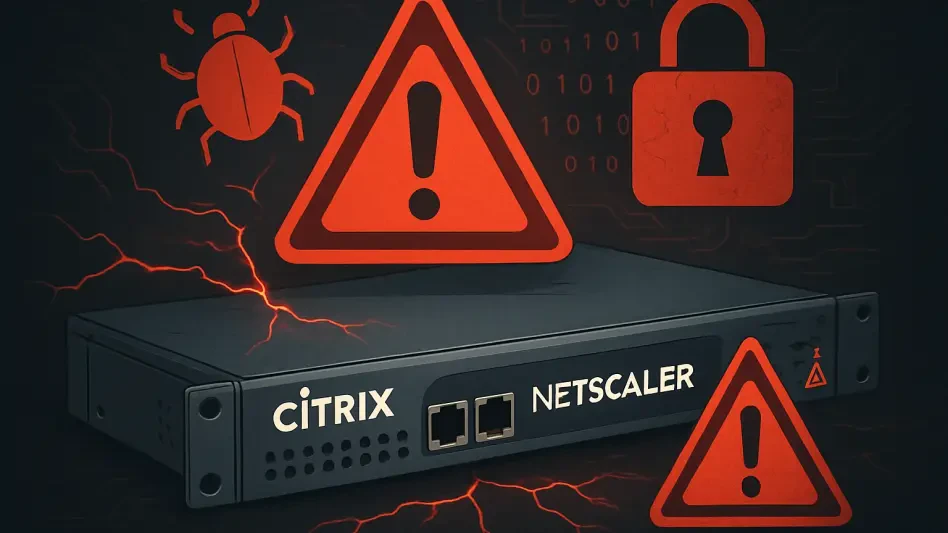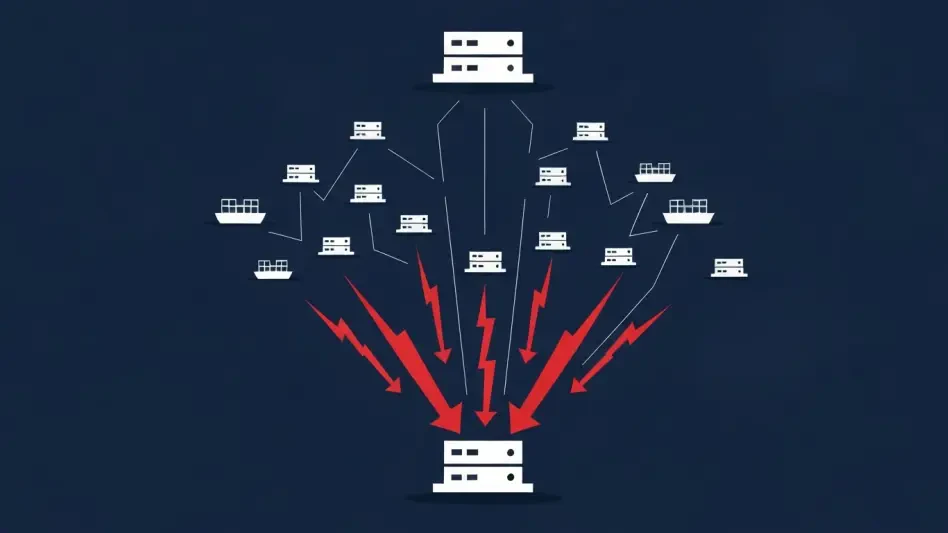In an era where cyber threats evolve at an alarming pace, the discovery of critical vulnerabilities in widely used systems can send shockwaves through industries reliant on secure digital infrastructure, and recent reports have unveiled severe flaws in Citrix NetScaler ADC (Application Delivery Controller) and Gateway devices, exposing organizations to significant risks. These vulnerabilities, actively exploited by sophisticated attackers, have targeted high-value sectors such as technology, banking, healthcare, and education. The urgency to address these issues cannot be overstated, as delayed responses could lead to devastating breaches. With thousands of systems still unpatched, the potential for data compromise looms large, demanding immediate attention from IT teams and security professionals worldwide.
Understanding the Vulnerabilities
Nature of the Threats
The spotlight falls on two critical vulnerabilities identified in Citrix NetScaler systems, known by their identifiers CVE-2025-6543 and CVE-2025-5777, with the latter also dubbed CitrixBleed 2. These flaws have emerged as significant concerns due to their active exploitation by malicious actors. CVE-2025-6543, exploited as a zero-day vulnerability since early May, remained undetected for nearly two months before Citrix issued a patch on June 25. During this period, highly targeted attacks struck critical organizations, particularly in the Netherlands, as confirmed by the Dutch National Cyber Security Centre (NCSC-NL). The stealthy nature of these attacks, designed to erase traces and hinder forensic analysis, underscores the sophistication of the threat actors. This vulnerability poses a severe risk to systems that remain unpatched, as attackers have demonstrated an ability to infiltrate high-security environments with precision and minimal detection.
Equally alarming is CVE-2025-5777, a buffer over-read flaw that has seen a sharp increase in exploitation attempts since late July. Security researchers at FortiGuard Labs have documented over 6,000 attempts, with significant activity recorded in the US, Australia, Germany, and the UK. Unlike the targeted nature of the other flaw, this vulnerability has attracted widespread attention from cybercriminals seeking to exploit any unpatched systems on a mass scale. The geographic spread of these attempts highlights the global reach of the threat, affecting organizations across diverse sectors. The rapid escalation in attack volume signals a race among malicious actors to capitalize on this flaw before organizations can respond effectively. This broad targeting amplifies the urgency for system administrators to prioritize updates and monitor for signs of compromise in their networks.
Impact on Critical Sectors
The repercussions of these vulnerabilities extend far beyond isolated incidents, striking at the heart of critical industries that form the backbone of modern economies. Sectors such as banking, healthcare, technology, and education have been identified as primary targets, where the stakes for data security are exceptionally high. In the Netherlands, for instance, the NCSC-NL reported that sophisticated attacks leveraging CVE-2025-6543 impacted key organizations, including a notable breach involving the Dutch Public Prosecution Service through Citrix systems. Although the specific flaw exploited in this case remains undisclosed, the incident illustrates the potential for severe operational disruption and loss of sensitive information. These attacks threaten not only financial stability but also public trust in institutions tasked with safeguarding personal and national data.
Moreover, the mass exploitation attempts tied to CVE-2025-5777 reveal a different but equally troubling pattern, as attackers cast a wide net to compromise systems across multiple regions. The sheer volume of attempts recorded by security entities points to a calculated effort to exploit vulnerabilities before patches can be applied universally. High-value sectors are particularly vulnerable due to the vast amounts of data they handle and the critical nature of their services. A successful breach in these areas could lead to cascading effects, disrupting essential services and exposing proprietary or personal information to unauthorized access. The persistent targeting of such industries emphasizes the need for robust cybersecurity measures and rapid response strategies to mitigate risks before they escalate into full-scale crises.
Mitigation and Response Strategies
Immediate Actions for Organizations
Addressing these vulnerabilities requires swift and decisive action from organizations using Citrix NetScaler devices to protect their digital assets. Citrix has released patches for both identified flaws, marking a crucial first step in securing systems against exploitation. However, merely applying updates falls short of a comprehensive defense. As highlighted by the NCSC-NL, resetting established sessions is equally vital to eliminate any lingering access points that attackers might exploit post-patch. This additional measure ensures that compromised connections are severed, reducing the risk of continued unauthorized access. Organizations must also conduct thorough audits of their systems to detect any signs of prior infiltration, especially given the stealthy tactics employed in attacks related to CVE-2025-6543. Proactive monitoring and immediate response to suspicious activity can make a significant difference in preventing data loss.
Beyond patching and session resets, collaboration with national cybersecurity incident response teams offers a critical lifeline for affected entities. The NCSC-NL, for example, is actively investigating the scope of these attacks and working with organizations to identify new indicators of compromise. Security tools are being updated regularly to assist in detecting breaches, providing a valuable resource for IT teams under pressure. The Shadowserver Foundation has also raised alarms about thousands of unpatched NetScaler devices still exposed to threats, underscoring a widespread delay in applying necessary updates. This persistent vulnerability gap suggests that many organizations may lack the resources or awareness to act promptly. Therefore, prioritizing communication and resource allocation for cybersecurity updates becomes essential to close these gaps and fortify defenses against ongoing and future threats.
Long-Term Security Considerations
Reflecting on the incidents, it became evident that a reactive approach to cybersecurity had left many systems vulnerable to exploitation over extended periods. The collaborative efforts of entities like FortiGuard Labs, NCSC-NL, and the Shadowserver Foundation played a pivotal role in mapping the scale and impact of the attacks, providing actionable intelligence to affected organizations. Their work shed light on distinct exploitation patterns, from targeted zero-day attacks to mass attempts, which informed tailored mitigation strategies. These partnerships proved instrumental in supporting breached entities and updating detection tools to counter evolving threats.
Looking ahead, organizations must adopt a proactive stance by integrating regular system updates and vulnerability assessments into their security protocols. Investing in advanced threat detection mechanisms and fostering a culture of cybersecurity awareness among staff can prevent similar incidents. Establishing robust incident response plans, alongside collaboration with global security networks, ensures readiness for future challenges. The lessons learned from these events emphasized that vigilance and preparedness were non-negotiable in safeguarding critical data against sophisticated cyber adversaries.








